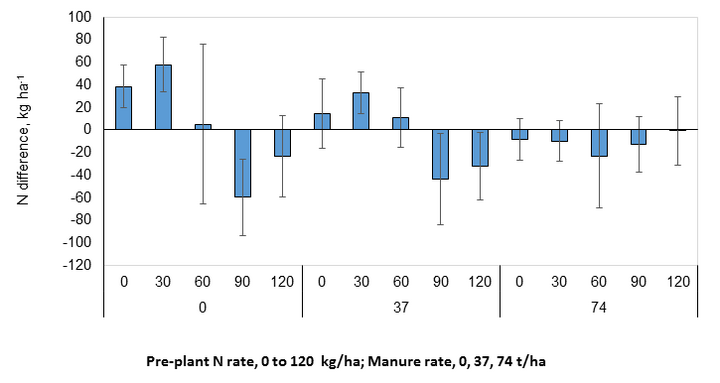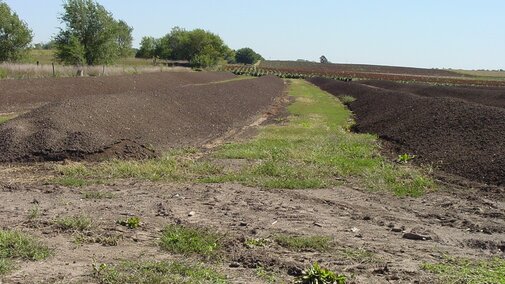Land application of organic materials for soil management in Nebraska is important.
- Organic N applied annually to Nebraska cropland is equal to 150 lb/ac N applied to about 1.3 to 1.6 million acres.
- Beef feedlot manure is the main organic material applied, but manure from other livestock types, municipal bio-solid by-products, and organic industrial wastes are also important. We refer to all as manure in the following.
- The availability of applied organic N and the fertilizer N substitution values of applied organic materials is not well predicted.
- The uncertainty of applied organic N availability leads to over-application of fertilizer N, resulting in low N use efficiency of applied N.
- Canopy sensor-guided in-season N application practices have been validated for corn produced on unmanured fields and may be a way to greatly improve N use efficiency for applied organic N.
- Application of 30 to 60 lb/acre of fertilizer N pre-plant followed by in-season fertilizer N application according to crop need may greatly improve applied N recovery and use efficiency.
- The canopy sensor practices may need calibration for manured fields, possibly with variations due to manure type and years since manure was applied.
The Research
The objective was to validate or adapt canopy sensor-guided in-season N application practices for manured fields.
The Methods
- Two sets of trials
- Set 1 trials were at Brule (2014-2016) and at the Eastern Nebraska Research and Extension Center (ENREC) (2015-2017) with 0, intermediate, and high levels of composted or stockpiled feedlot manure applied. Each manure level had a set of N ramp treatments with 27 lb/acre N rate increments to 107 lb/ac, and a high N reference strip of 178 lb/ac, applied before planting.
- Set 2 trials were at six locations in eastern Nebraska with eight organic materials during 2016 and 2017. The trials had an N ramp set of treatments as above with no organic material applied. No pre-plant fertilizer N was applied to the organic material treatments.
- The crop was continuous corn with no tillage.
- Crop canopy reflectance was sensed for NDRE (Normalized Difference Red Edge Index) periodically beginning at V8 to determine the optimal time for differentiation of stress.
- The plots for both sets of trials were split for with and without sensor-guided in-season N application.
- The algorithm for interpretation of sensor readings was: in-season N rate = 317√0.97 - SI
- Set 1 trials were at Brule (2014-2016) and at the Eastern Nebraska Research and Extension Center (ENREC) (2015-2017) with 0, intermediate, and high levels of composted or stockpiled feedlot manure applied. Each manure level had a set of N ramp treatments with 27 lb/acre N rate increments to 107 lb/ac, and a high N reference strip of 178 lb/ac, applied before planting.
- Set 2 trials were at six locations in eastern Nebraska with eight organic materials during 2016 and 2017. The trials had an N ramp set of treatments as above with no organic material applied. No pre-plant fertilizer N was applied to the organic material treatments.
- The crop was continuous corn with no tillage.
- Crop canopy reflectance was sensed for NDRE (Normalized Difference Red Edge Index) periodically beginning at V8 to determine the optimal time for differentiation of stress.
- The plots for both sets of trials were split for with and without sensor-guided in-season N application.
- The algorithm for interpretation of sensor readings was: in-season N rate = 317√0.97 - SI
where

- In-season N application was during V12 to v14.
- Grain yield and other variables were measured.
Results
 Figure 1. Difference between N needed for the achieved yield and that applied for three manure rates, each with 5 N levels at ENREC in 2015.
Figure 1. Difference between N needed for the achieved yield and that applied for three manure rates, each with 5 N levels at ENREC in 2015.
- Mean yield at ENREC was 10% more with manure applied compared with no manure, but at Brule there was no composted manure effect on grain yield.
- The in-season N rate at ENREC was 43% and 17% less with manure applied compared with no manure for the year of application and for the mean of the second and third year after application, respectively. The in-season N rate was 23% less with manure applied at Brule.
- The sufficiency index algorithm over-estimated N need when the pre-plant N rate was 0 or 27 lb/acre (30 kg/ha) (Figure 1).
- Yield potential was lost if the crop was too stressed by low N before the in-season N application.
- The best pre-plant N rate was about 55 lb/acre (60 kg/ha) N to avoid excessive low N stress while allowing for NDRE differences expressive of crop N need and a good match of fertilizer N needed for the achieved yield and the fertilizer N actually applied.
- The best time for canopy reflectance sensing was determined to be between V12 and V14.
- The above SI algorithm worked well and maybe better for manured compared with unmanured fields (Figure 1). Data analysis has not yet finalized improvements to the algorithm either for manured or unmanured fields.
- While the yield was more and the in-season rate was less, the fertilizer N use efficiency was not improved with canopy sensor-guided in-season N application.
- In a preliminary comparison of the above algorithm with another used in Nebraska, the latter tended to under-apply in-season N. This needs further data analysis.

Further analysis with the 2017 data and all locations may indicate revisions for the algorithm.

